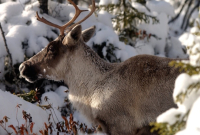Support strong Canadian climate journalism for 2025
The Quebec government says a dwindling caribou herd will die out unless they are relocated from their western Quebec range to a five-square-kilometre zoo—but environmental groups say it’s just an excuse to intensify forestry and mining in the region.
Just 17 woodland caribou are left in an isolated herd near Val-d’Or, in western Quebec. Last week, the provincial Ministry of Forests, Wildlife and Parks said the caribou would be captured and moved to a zoo in Sainte-Félicien, about 300 kilometres north of Quebec City. The zoo is 100 times smaller than 500 square kilometres the federal government has said is necessary for a caribou herd to thrive.
The herd has shrunk by half in the past five years, and the province and environmental groups agree that they appear headed for extinction. The province says the extreme move is a “new start,” and the only way to save the handful of remaining caribou.
But environmental groups say the decision doesn’t make sense – and could be an excuse to expand mining and forestry development in the area.
“It creates a dangerous precedent,” said Pier-Olivier Boudreault, director of conservation and forestry at the Société pour la Nature et les Parcs du Canada (SNAP). “When we fail to protect their habitat and have management measures, we just move them.”
Logging road plans "contrary to every recommendation"
A herd with fewer than 50 individuals has little hope of surviving, according to Quebec government research.
Their habitat, at the centre of a busy mining and logging area, has been carved up and disrupted by logging and human activity – far beyond the point that the caribou can be expected to recover, according to an environmental assessment from the Quebec government.
In the assessment, biologists concluded that approving a request from forestry company EACOM to build a logging road through the Val-d’Or caribou habitat would be “contrary to every recommendation from the provincial … and federal governments regarding protection of woodland caribou."
The province tried to keep that assessment secret, but it was made public in February during environmental impact hearings on a proposed open-pit gold mining project near Val-d’Or.
By removing the caribou, which have acted as a barrier to more intense development, the province is creating an “open door for industry” in the region, Boudreault said. As long as the caribou survive in Val-d’Or, the Quebec and federal governments are legally obligated to protect them, and forestry companies have to try to mitigate their impact on caribou habitats. Move them, and those protections disappear, Boudreault said. “Even if the population perishes in 10 or 20 years, it will benefit other species,” he said.
"Jailing them behind bars"
Greenpeace forest campaigner Olivier Kolmel said the organization is “pretty appalled” by the decision. “Transferring a vulnerable species to the zoo is absurd. It’s just not the right step,” Kolmel said in an interview.
Kolmel said Greenpeace is concerned about the small size of the herd’s new habitat at the St-Félicien zoo and noted that in 2015, 19 of the zoo’s 21 caribou died suddenly after exposure to what was believed to be a parasite.
“This is basically jailing them behind bars,” Kolmel said.
He said Greenpeace and other groups have pressed the province to explain what other options were considered for the caribou. So far, they’ve refused. “We’re just supposed to take that information at face value,” he said.
“Is this a smart move, or is this just sending them to their death?” Kolmel asked.
"This decision was made strictly to ensure the survival of the 17 caribou who comprise the small Val-d'Or herd," MFFP spokesman Jacques Nadeau said in an email.
The Val-d'Or caribou's former habitat "will be maintained and will remain an example of the type of habitat that will have contributed to the survival of a woodland caribou population," Nadeau said. "It will continue to play an important role for the other species present."
"We don’t need to make them the pandas of Canada”
SNAP’s Boudreault said the decision reflects “a strange view of conservation.” The government is missing the forest for the trees, he said. “They want to save the individuals, but protecting caribou isn’t about saving the individuals ... It’s really about protecting the population, and the habitat for the benefit of other species, the ecosystem itself and also for human benefit.”
Caribou are threatened, but not so rare that each one needs to kept in captivity and protected like pandas, he said. “We don’t need to make them the pandas of Canada.”
Instead, the provincial government should focus on implementing a caribou action plan it announced last year, Boudreault said. "It’s a two-phase plan and we’re still expecting the first phase," he said. "I’m getting less and less confident as time goes by."
Most other caribou populations in Canada's boreal forest are in decline. According to federal government data, just 19 per cent of those herds are stable or growing, and the country’s caribou herds are expected to shrink by almost a third within the near future.
Research commissioned by the Quebec government in 2012 shows three herds near James Bay, north of the Val-d'Or herd, have been in decline for at least a decade, mostly because of human activity, including logging.
The Canadian Parks and Wilderness Society, which is SNAP’s Canadian parent association, announced last week that its lawyers are suing the federal government to demand that Environment Canada produce regular reports on the state of the threatened woodland caribou. Canada’s Species at Risk Act requires Environment Canada to report every six months on the species at risk, and to explain what measures are being taken to protect them. CPAWS says that hasn't been done since 2012.
If left alone, the Val-d’Or herd might have a decade or two before they’re gone for good, Boudreault said. He previously told National Observer that he wasn’t optimistic that the province’s conservation measures would work, and that money budgeted for the shrinking Val-d’Or herd would be better spent on other herds in Quebec, which might still have a fighting chance. “But we need a commitment that this won’t happen to other populations,” he said.
Editor's note: This story was updated at 5:10 p.m. ET to add comment from the MFFP.






Comments